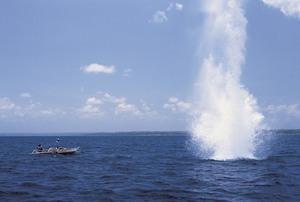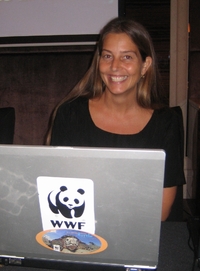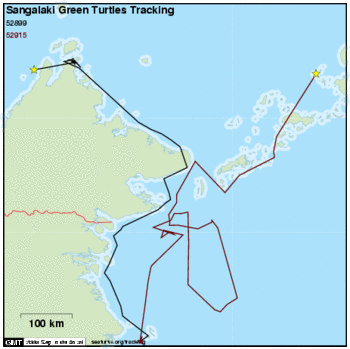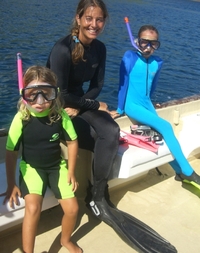by Mallika Naguran

Bombs destroy precious ecosystems. © Jürgen FREUND / WWF-Canon
Fishing methods using blast or cyanide, long haul nets or hook lines often catch innocent bystanders off guard such as turtles and dolphins. All this keeps a woman tossing and turning in the nights. Dr Lida Pet-Soede, leader of the CoralTriangle Network Initiative with WWF, speaks of how certain species are dwindling as a result of poor fishing methods such as the Olive Ridley and Hawksbill turtles.
“Malaysia in the 60s had so many Leatherbacks and nesting grounds, now less are coming back and we wondered what’s happening here?” says the Netherlands-born fishery biologist based in Bali. Six out of world’s seven turtle species are either endangered or critically endangered, while the status of the seventh is unknown.

Technology is critical in conservation: Dr Lida.
A strategy to curb bad practices and promote good ones is to educate communities and government authorities by using methods that are readily grasped. This, Lida has found, to be more effective than the previous way of churning technical data with no means of translating into everyday terms.
Satellite Tracking
First, satellite technology is used to plot marine creatures in their natural habitats. In the case of turtles, a transmitter tagged to turtles help churn real-time data on their movements and studied over time. “We started with 25 turtles in 2005 with the US Government’s support, and now we have tagged more than 100 turtles successfully,” she adds, “including the Olive Ridley and Hawksbill which have been difficult to locate.”
The movements show where turtles lay their eggs, and thereafter where they migrate to. This information is used to influence policy-making with regard to the protection of beaches. “Technology in the last couple of years has been increasingly critical for us in turtle conservation in the Coral Triangle,” she shares.
The undersea migratory movements also help WWF identify crucial areas for turtle protection such as creation of marine protected areas (MPAs). In 2007, two green turtles on Sangalaki Island off Indonesia were fitted with a lightweight satellite transmitter. Marina, an 88kg green turtle whose curved shell measures about 96cm was found on Sangalaki Island on 13August 2007, laying her clutch of eggs.
Carolina, a bigger and older green turtle at 112cm long and weighing a hefty 150 kg was also fitted with a transmitter and left Sangalaki on the same day as Marina. Both, however, parted on different journeys (see map).

Turtle tagged with satellite transmitters. Photo by Windia Adnyana.
At the end of the transmitter’s three-month battery life, with satellite tracking, they found that Marina had swum almost 680 miles. She stayed close to Indonesia and Malaysia coastlines, stopping along the way in a number of MPAs that WWF helped establish. This includes the Turtle Islands Park and the proposed Tun Mustapha MPA (her last-recorded location at 93 days).
Typical of an older turtle, Carolina headed out into open waters, moving up through the Sulu Archipelago. When her transmitter gave out after 98 days in November, she had logged 1,100 miles near Basilan Island in the Philippines. There are currently no MPAs in this region; continued armed conflict has limited the opportunities for conservation action.

Marina heads up north while Carolina swims northeast. © WWF
Such data gets Lida all excited. “It’s important for us to know where they go, so if they disappear, we can know at once what happened. Once a leatherback swam all the way from Irian Jaya to California! That put our work in the right perspective as we realized then that we had to go beyond beaches to work on the East Pacific oceans.”
Circle Hooks
Another breakthrough in reducing bycatch is something stunningly simple - the use of a different shaped fishing hook, that is, a circular one instead of the traditional J hooks. The sharp point on a circular bait points inward; this does not harm turtles that swallow it, but hooks the fish.
“We had to persuade long line tuna fishermen to try these new hooks, especially those in Indonesia, Philippines, the Pacific and Malaysia. They were apprehensive at first, but upon trying them, they caught as many tuna without harming turtles, and they told others about it,” smiles Lida.
Riding on the success of these trials, WWF is looking into the manufacture of steel circle hooks with the hope of replacing traditional ones.
PhotoVoices
Another unconventional method to engage the community in a down-to-earth manner, shares Lida, is the use of camera images or PhotoVoices International, developed by Ann McBride with the support of Ford Foundation and National Geographic. Lida describes how the whale-hunting Lamalera village in Lembata island, eastern Indonesia were provided with cameras and taught how to use them. They were told to photograph anything that was of importance to them.

Unseen, silent tragedies. Photo © Michel GUNTHER / WWF-Canon
“Some took pictures of their children, some the sea, some the whales and we use these as a starting point to introduce conservation as a means of upholding what’s of high value to them,” she explains. “For instance they say there aren’t many whales in the sea anymore, and we explain how that has happened. This makes them understand the impact of over fishing.”
The international whaling treaty exempts the people of Lamalera from the ban on whale hunting, on the grounds that this is a unique and traditional way of life. Use of harpoons, for instance, is common. The project caught the villagers' imaginations as they also used the images to teach their young ancient cultures while embracing new environmental concepts.
WWF strategies such as community engagement and establishment of MPAs are in addition to others such asdevelopments for poverty alleviation, community-based ecotourism, establishment of fisheries and sustainable live reef fish trade, and more.

Eva, 5 and Laura, 10 follow mom's finsteps.
Maybe Lida sleeps better now, knowing that some of the Coral Triangle initiatives are in place to protect her precious turtles while providing for communities’ livelihoods.
Photos by WWF.
More information on WWF, visit www.wwf.org.
Email Dr Lida Pet-Soede at lpet@wallacea.wwf.or.id
PhotoVoices at www.photovoicesinternational.org